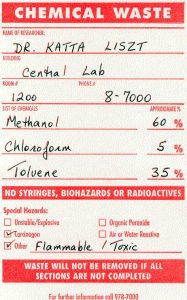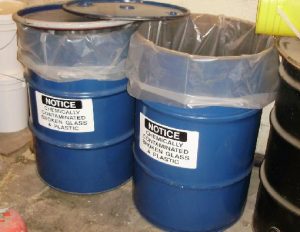Laboratory Hazardous Waste Management and Disposal Manual
5. Specific Waste Management Requirements
5.2 Chemical Waste Management
5.2.1 Definition
5.2.2 Packaging
5.2.3 Labelling
5.2.4 Storage
5.2.5 Special Cases
5.2.6 Collection Schedule
Chemical wastes are not treated on campus; the majority are recycled. Of the organic wastes produced, 100% are recycled through various industrial processes. Depending on the composition, 50-75% of the inorganic chemical wastes are also recycled. Those chemicals that cannot be recycled are treated by external contractors. For further information contact the Manager, Environmental Protection, Environmental Protection Services at 416.978.7000 or e-mail eps.hazdisposal@utoronto.ca.
5.2.1 Definition
Chemical waste includes solids, liquids or gases containing or contaminated with any of the following:
- flammable solvents (e.g., acetone, alcohols, acetonitrile);
- leachate toxic materials (e.g., heavy metals, pesticides);
- corrosives (e.g., hydrochloric acid, potassium hydroxide pellets);
- reactives such as oxidizers, cyanides, sulphides, explosives, unstable materials and water-reactive materials (e.g., sodium metal, benzoyl peroxide);
- toxic materials including mutagenic, carcinogenic, acute or chronic toxicity materials (e.g., chloroform, ethidium bromide);
- polychlorinated biphenyls (> 50 ppm concentration);
- non-returnable gas cylinders.
5.2.2 Packaging
In addition to the general packaging requirements outlined in Section 4, these specific requirements for chemical waste must be followed:
- Never mix incompatible materials together in a single container (see Section 5.2.4.1).
- Wastes must be stored in containers compatible with the chemicals stored. For example, hydrofluoric acid waste must not be stored in glass containers, corrosive chemicals must not be stored in metal containers, etc.
- Solvent safety cans should to be used to collect and temporarily store large volumes (10-20 litres) of flammable organic waste solvents. The researcher is responsible for providing these cans to the laboratory. Cans submitted for disposal will be emptied and returned promptly to the laboratory, provided that they are properly identified with the building and laboratory room number.
- Do not insert precipitates, solids or other non-fluid wastes into safety cans.
- Package halogenated and non-halogenated solvents separately, if possible. The University pays a premium for disposing of halogenated solvents (e.g., chloroform, carbon tetrachloride).
- Do not package solid chemical waste into biohazard bags, because this incorrectly indicates a hazard that is not present.
- Buildings with Central Waste Storage will have drums for contaminated glass and plastic where lab staff can empty their containers into. (see picture below)
5.2.3 Labelling
In addition to the general labelling requirements outlined in Section 4, these specific requirements for chemical waste must be followed:
- Attach a Chemical Waste label directly to the waste container. Chemical waste labels are available free of charge from EPS staff.
- All information requested on the Chemical Waste Label should be provided. Chemical generic names of the chemicals must be listed. No abbreviations, acronyms or trade mark names are to be used. Vague categories (e.g., solvent waste) are not acceptable. See Figure 1 for completed example of a chemical waste label. Download pdf fillable version

Figure 1: Example of Properly Completed Waste Label
5.2.4 Storage
In addition to the general storage requirements outlined in Section 4, these specific requirements for chemical waste must be followed:
- Waste chemicals should be stored in the central waste-holding facility of the building. Should such a facility be unavailable, the chemical waste should be temporarily stored in the generator’s laboratory. Contact your supervisor or EPS staff for the location of the central chemical waste facility in your building.
- All safety precautions required for handling and storage of chemicals will also be observed for generated wastes.
- Waste should be segregated according to compatibility groups such as acids, bases, flammables, oxidizers and water reactives and not according to alphabetical order. See Section 5.2.4.1 for chemical compatibilities or consult EPS staff.
- Dispose of aging containers promptly. Some chemicals are time sensitive and may degrade into very hazardous by-products; e.g.,ethers may degrade to form explosive organic peroxides.
5.2.4.1 Chemical Compatibility
When preparing chemical waste for disposal, it is the generator’s responsibility to ensure that incompatible chemicals are not stored in the same container. Waste containers should be stored according to their compatible chemical reactivities. A few general examples are:
- Acid-reactive compounds (e.g., cyanides, sulphides) which liberate gaseous products when acidified should not be mixed with any inorganic acid (e.g., sulphuric or hydrochloric acid).
- Organic acids (e.g., glacial acetic acid) should be segregated from inorganic acids. Generally inorganic acids are oxidizing agents while some organic acids may be either reducing agents or combustible.
- Water reactive materials (e.g., sodium) should be kept away from any water source.
- Oxidizers (i.e., any inorganic compound that assists fire such as hydrogen peroxide, lead nitrate) should never be mixed with organic materials (e.g., organic bases such as pyridine, aniline, amines, flammable solvents such as toluene, acetone) or reducing agents (e.g., water-reactive chemicals such as sodium).
Note: Perchloric acid, although an inorganic acid, is a powerful oxidizing agent and should be considered a powerful oxidizer in its concentrated form.
For any wastes that require special handling such as organic peroxides, PCBs (polychlorinated biphenyls) or explosives, consult the Manager, Environmental Protection, Environmental Protection Services 416.978.7000 or e-mail eps.hazdisposal@utoronto.ca.
5.2.5 Special Cases
The preceding procedure dealt with common teaching and research chemical wastes generated by the University. Occasionally chemical wastes are generated that require additional or special handling, as discussed below.
Asbestos
Asbestos-containing materials such as bunsen burner pads, gloves etc., are disposed of by Facilities and Services Trades staff trained in the proper handling of these materials. Contact your building’s property manager
Batteries
Household batteries should be placed into battery recycling containers placed around campus. Drop-off containers are provided by Facilities and Services and a list of the location is found here. PLEASE make sure to apply tape on terminals of all litium batteries before dropping them off. For further information contact the Recycling Coordinator at 416.946.5711. All other batteries (i.e., 12 volt or larger) are collected directly by EPS staff.
Empty Drums
Empty drums (20 to 205 litre capacity) will be removed by EPS staff.
Ethidium Bromide
All materials contaminated with ethidium bromide, including solids (e.g. gloves) should be packaged in a secure container, labelled and treated as chemical waste. Gels contaminated with ethidium bromide should be packaged in leak proof plastic containers (no garbage bags) and disposed as chemical waste.
Explosives
Do not handle explosive materials. Examples of explosives include materials such as trinitrated compounds (e.g., TNT), dry picric acid (<20% by weight water content), fulminated mercury, heavy metal azides (e.g., lead azide). These materials require special handling for disposal. These materials must be checked frequently for signs of deterioration and aging. These signs would include “sweating” of a container, bulging, crystal formation around the cap, etc. Deteriorating explosive materials are potentially more dangerous to handle than new explosives. Inform EPS immediately.
Gas Cylinders
All gas cylinders should be treated as high energy sources. Use the smallest size required to do the work. Prior to purchasing the cylinder check that empty cylinders can be returned directly to the supplier. Disposing of these materials elsewhere is extremely expensive and difficult. Contact the EPS Office for further information.
Mercury thermometers
Mercury thermometers for disposal should be treated as chemical waste. Broken thermometers should be considered contaminated and all free liquid mercury should be collected and packaged in a leak-proof container, together with all contaminated solids such as glassware, gloves used during the clean-up, etc.
Paint Cans
Expired or spent paint cans are normally disposed of as chemical waste.
Peroxidizable Compounds
These materials should be ordered in small quantities (less than 6 months supply) and dated when the container has been opened. Even if a commercial inhibitor has been added by the manufacturer, organic peroxide formation can begin within 6 months following exposure to air. The ordering of smaller quantities and the reduction of the volume of these materials in storage, encourages the quick turnover of inventory and reduces the likelihood of peroxide formation. Organic peroxides are explosive.
The following materials are potential organic peroxide formers:
Polychlorinated Biphenyls (PCBs)
The handling of PCB-contaminated waste materials requires special consideration for handling, storage and disposal. In Ontario, any waste material with a concentration of PCBs greater than 50 ppm is considered to be PCB-contaminated. Sources of PCBs include transformers containing the trade name Aroclor (or the generic fluid called askarel) which were commonly used in North America. Almost every capacitor manufactured between 1930-1980 contains liquid PCBs. PCBs were also used in a variety of applications including hydraulic equipment, electromagnets, heat transfer equipment and vapour diffusion pumps.
EPS staff can analyze samples to determine if they are PCB-contaminated. Special arrangements for disposal must be coordinated by Environmental Protection Services.
5.2.6 Chemical Waste Collection Schedules
Plan ahead when disposing of waste materials. Hazardous waste collection is arranged through the Environmental Protection Services at 416.946.3473 or by e-mail at eps.hazdisposal@utoronto.ca.
Waste collection is done on a first come first served basis and as quickly as possible. However with service provided to more than 1500 laboratories on the St. George campus alone, waste collection will usually occur within one week of a request.
- If a building has a central waste holding facility, the individual managing the area is responsible for scheduling collection.
- If hazardous waste is stored within a laboratory, it is the responsibility of the generator to schedule a waste collection.
- Hazardous waste must not be allowed to accumulate. The frequency of collection is dependent upon the type and amount of waste generated.
